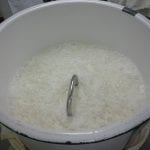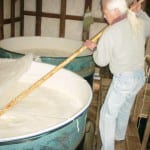How big is ideal?
 There are countless factors that determine how good a batch of sake will end up being. Some are directly controllable by brewers; others less so. And there are, nor surprisingly, countless opinions amongst brewers about each and every one of those factors. There are methods or practices that some brewers consider indispensable or key, yet other brewers will downplay or even outright contradict them with diametrically opposed philosophies. Like, 180 degrees. It can be odd, actually. Depending on your threshold for vagueness, it can either be frustrating or fascinating.
There are countless factors that determine how good a batch of sake will end up being. Some are directly controllable by brewers; others less so. And there are, nor surprisingly, countless opinions amongst brewers about each and every one of those factors. There are methods or practices that some brewers consider indispensable or key, yet other brewers will downplay or even outright contradict them with diametrically opposed philosophies. Like, 180 degrees. It can be odd, actually. Depending on your threshold for vagueness, it can either be frustrating or fascinating.
One of these factors is the size of the batch. Big batches behave differently than small batches, not surprisingly. A batch is called a “shikomi,” and its size is measured in kilos of dry, milled rice that went into a given tank to create that batch of sake. While there are of course myriad other ways a batch could be measured, the weight of the dry rice is how it is done in the sake world.
Off on a bit of tangent, why is that? Because just how much water the rice is allowed to
absorb, or how much water is added, or what the yields are will vary based on many things as well. Basing size on the weight of the dry milled rice presents one parameter that can be used as a point of comparison for all tanks, all batches, and all brewers.
Perhaps the most commonly encountered size of a typical shikomi is a ton to a ton-and-a-half (a metric ton, mind you, so 1000 kg or 2200 pounds) of all the rice that went into the tank, be it sraight steamed rice or koji rice (the rice that has had koji mold propagated upon it). But there are many brewers of the opinion that much smaller shikomi, say 600 kg or so, are infinitely better for super premium sake.
Perhaps the smallest size I have seen is 500kg on a practical level. (Experimental batches notwithstanding, of course. I have seen batches of sake in a desktop Pyrex jar.) But done at this scale, yields are quite low. The economics of sake brewing are, of course, important, and brewers need to ask themselves, from that point of view, are tiny batches worth it in the end?
 When considering the time required to do each of the many steps, then have it take up tank space, press it and filter it when fermentation is complete, bottle it and care for it and more – it would be so much more economical to double, triple or quadruple one’s yields; yea, verily I say unto thee multiply them by ten-fold for true efficiency. And, of course, many breweries function at such large economies of scale.
When considering the time required to do each of the many steps, then have it take up tank space, press it and filter it when fermentation is complete, bottle it and care for it and more – it would be so much more economical to double, triple or quadruple one’s yields; yea, verily I say unto thee multiply them by ten-fold for true efficiency. And, of course, many breweries function at such large economies of scale.
Naturally, though, as economically sound as larger batches can be at some point the law of diminishing returns kicks in with a vicious vengeance and quality begins to noticeably suffer. But just where that occurs, and how each brewery factors that into their lineup varies hugely.
For example, some brewers not think that smaller batches are always better, citing the truth that it is much harder to control parameters such as temperature in those smaller tanks over the long run. To achieve a given flavor and aromatic profile, brewers guide the moromi (fermenting mash) along a very tight temperature curve. Smaller batches are more subject to various factors that might send them out of spec, so to speak. For a really small tank, a warm day outside might let the moromi get too warm, adversely affecting the final product.
Conversely, a largish tank would lumber along much more sluggishly so that wild swings in temperature et al would not likely happen. A warm day outside is nothing to a ton-and-a-half of fermenting rice. Such a tank would look askance at the weather outside, secure in its sheer mass.
But of course the other side of this coin is that if the temperature and other parameters stray from the fold of the ideal, it is easy to bring them back into alignment with small batches, back to where they should be, whereas in big batches, there is nothing to little that a brewer can do once things have gotten too out of spec.
 Yet more dissention abounds. One hugely famous toji of almost unmatched accomplishment insists that larger batches of about 1.5 tons are ideal. He also insists on slightly customizing the shape of the fermentation tanks he uses, so that the sake in his brewery circulates natural as it ferments. This means that they do not have to mess with using long poles to mix it up. It all occurs naturally in his kura as, inside the tanks, carbon dioxide bubbles stick to dissolving rice particles and the countless yeast cells, rising to the top, where the gas is released and the now-dense glob sinks again. And if your shikomi size is right, it all circulates perfectly, around and around and around…
Yet more dissention abounds. One hugely famous toji of almost unmatched accomplishment insists that larger batches of about 1.5 tons are ideal. He also insists on slightly customizing the shape of the fermentation tanks he uses, so that the sake in his brewery circulates natural as it ferments. This means that they do not have to mess with using long poles to mix it up. It all occurs naturally in his kura as, inside the tanks, carbon dioxide bubbles stick to dissolving rice particles and the countless yeast cells, rising to the top, where the gas is released and the now-dense glob sinks again. And if your shikomi size is right, it all circulates perfectly, around and around and around…
Having said all this, though, it is a fact that almost always the more premium grades of sake are indeed made in comparatively smaller batches, compared that is to the shikomi size of the lower grades of sake for a given brewer. And contest sake, too, is almost without exception made in smaller batches. Certainly this is due to the aforementioned ability to tightly control key parameters.
Admittedly, this information is more than most of us need or want to know. Most folks are more into tasting sake than the under-the-hood workings of the brewing process. But lately I have come across this information on the back labels of one or two sake bottles: they actually tell us the size of the shikomi!
In truth, I think such information is superfluous and even intimidating. I mean, really; who cares? In the end, the flavors and aromas of a sake before us are either appealing, or they are not. Biasing our minds with such information before tasting could actually encumber our enjoyment by unnecessarily prejudicing it.
But as always, there are a myriad of opinions. One big gun of a distributor in the Tokyo/Yokohama metropolis insists that sake must be made in 600 kg or smaller batches to even be decent. He cites his ten-year convincing effort focused on one famous kura to lower their shikomi size from a ton to 600 kg, and when they did, they won a major international award. True, the smaller shikomi size might have had something to do with it, but so might a gazillion other things. But hey, what do I know.
So enjoy your sake for its flavors and aromas. Should you come across the shikomi size on a label or in a kura, bear in mind its significance, and its potential liabilities.
~~~~~~~~~~~~~~~~~~~~~~~~~~~~~~~~~~~~~~~~~~~~~~~~~~~~~~~~~~~~~~~~~~~~~~
Sake Professional Course in Chicago
April 23 ~ 25, 2019
 From Tuesday, April 23 to Thursday, April 25, 2019, I will hold the 30th North American running of the Sake Professional Course at the restaurant Sunda, in Chicago, Illinois. The content of this intensive sake course will be identical to that of the Sake Professional Course held each January in Japan, with the exception of visiting sake breweries.
From Tuesday, April 23 to Thursday, April 25, 2019, I will hold the 30th North American running of the Sake Professional Course at the restaurant Sunda, in Chicago, Illinois. The content of this intensive sake course will be identical to that of the Sake Professional Course held each January in Japan, with the exception of visiting sake breweries.
The course is recognized by the Sake Education Council, and those that complete it will be qualified to take the exam for Certified Sake Specialist, which will be offered on the evening of the last day of the course.
You can learn more about the course here, see the daily syllabus here,and download a pdf here. If you are interested in being in the mailing list for direct course announcements, please send me an email to that purport.
Testimonials from past graduates can be perused here as well.




